|
From Mazatlán to Guadalajara
Mazatlán
I slept pretty well on the sofa in the ferry's music salon. Although the guards first insisted that I was not allowed to put my (shoe-less) feet on the sofa, after midnight they stopped bothering me. When I arrived in Mazatlán, it had just stopped raining, the huge puddles in the streets making the ride to my hotel more difficult. I saw the city, but started by eating a proper breakfast in a pub on the square. As it was 11 o’clock, it was really brunch. I went through quite an interesting historical center, where some houses had been restored and others were literally on the point of collapse. The condition of the sidewalks was catastrophic. They do not observe the height of the sidewalks there, so one person can have a sidewalk even half a meter higher than his neighbor.
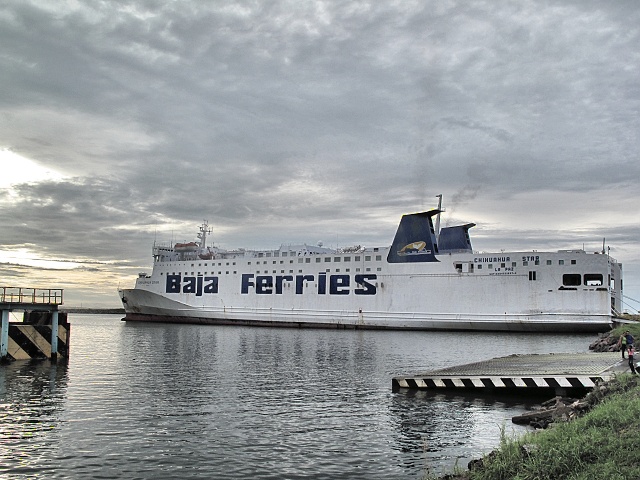
[Mazatlán] Ferry landing on a rainy morning
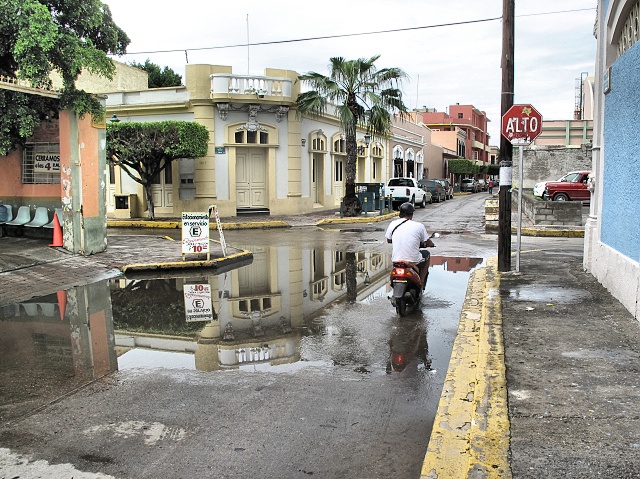
[Mazatlán] Just a little rain causes problems, the puddles were up to 30 cm deep
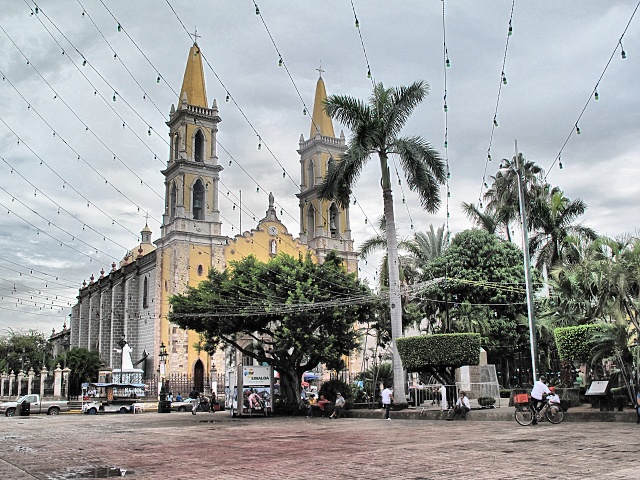
[Mazatlán] 19th-century Cathedral – naturally the highlight of the town

[Mazatlán] Impressive interior decor of Cathedral
Then I walked along a beach promenade several kilometers in length, lined with beaches and seafood taverns right on the sand. Along the way, I saw cliff jumpers. Two guys aged about 20, were jumping into a relatively small space between the rocks. They waited for a few tourists to come, agreed on a price with them and then climbed up the cliff and, after a moment of dramatic hesitation, cut a wonderful jump into the churning waves which seemed very dangerous. I went to the tourist resort of Zona Dorada, which seemed nothing special to me. I waited for the local public transport – colectivo – which operates day and night. For about half a dollar, I experienced an adrenalin ride in the crowded city, where our driver was racing a colleague and they were overtaking each other. In the evening, I discovered a glassmaker, took my mirror to him and, in 10 minutes and for 20 pesos, he produced a new glass for my bike mirror. Of course it was not panoramic, the original mirror was concave and made of special thin glass. But still I admired how skillful he was. I only could not find a detailed road map, so I only had a road atlas. I would try to get the map at a gas station along the way.

[Mazatlán] A jumper getting ready to jump off the cliff
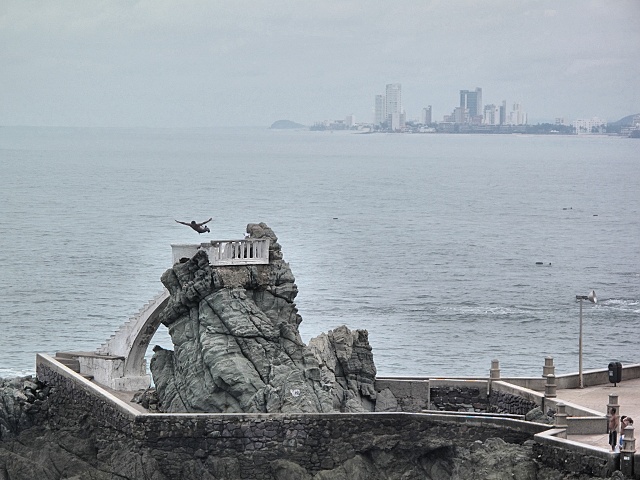
[Mazatlán] Jumper gliding over the rock
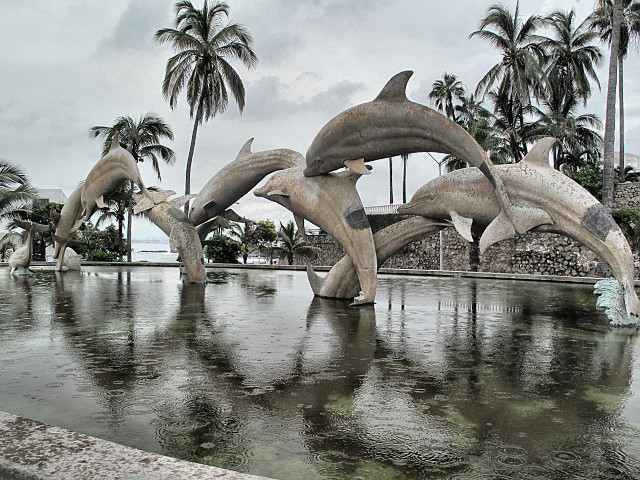
[Mazatlán] A famous sculptural group on the seaside promenade

[Mazatlán] Zona Dorada tourist resort
Finally on the Road Again
After several days of inactivity caused by the sea crossing, the morale on board had begun to decline. The best way to overcome it was by cycling. By the way, I learned on TV that, one day after I had left, La Paz was attacked by a Georgette hurricane, a storm with heavy rain. My proverbial luck had held again. Such weather would have swept me off the road uncompromisingly. .
The Mazatlán streets were filled with deep puddles after the night's rain. Soon I was spattered with dirt and the bike frame could not be seen under the mud layer. I wanted to wash the bike at a gas station, but I thought that this would not be the end.. And I was right. The road in front of Villa was under repair. An approximately 3-kilometer detour led across a tank training area, the depth of the puddles was typically half a meter. Then there was one which was almost a crater. Workers had tried to drain the water, but had a short hose and so the pumped water just flowed back. Here I reigned with the bike, I could cycle around the puddles and overtake everybody. In Rosario, I had lunch in a cocina economica, which sold very good, cheap food, with a choice of 5 options. I combined three types of food, to be able to taste the different dishes. The weather here was different from that in Baja, with lower temperatures but significant humidity, simply a steam bath. And it rained, showers in the afternoon, heavy rain in the evening, and then rain all night. Then there was the smiling sun again in the morning, as the sky cleared. The landscape was lush and green, soaked with water, fenced, because something was growing everywhere. Obviously there were fewer possibilities to sleep out in the wilds, but I was sure to find something. But, for safety reasons, I preferred motels or hotels. They were cheap (150-350 CZK per night). I could take a shower and enjoy the town in which I spent the night.
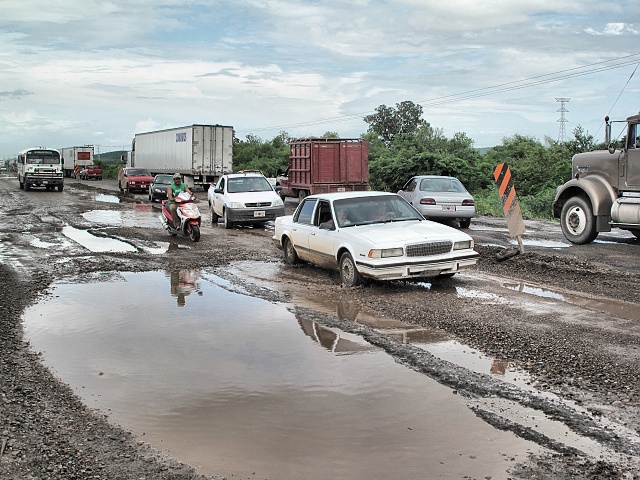
[Villa] I playfully overtook all the cars on the detour of about 3 km on this really shocking road
I spent one night in Escuinapa de Hidalgo. On the square, I asked policemen about a hotel. They asked whether I preferred expensive or cheap, and then sent me to a hotel a few blocks away. While we were speaking, a car stopped and the driver asked if we needed interpretation into English. The officers replied that they did not need his interpretation and that we were communicating just fine. My few memorized sentences really worked! By the way, the Police are richly represented here—Federal, State, Municipal, Preventive, Transport, Tourist Assistance, and maybe there were some others I had not even noticed.
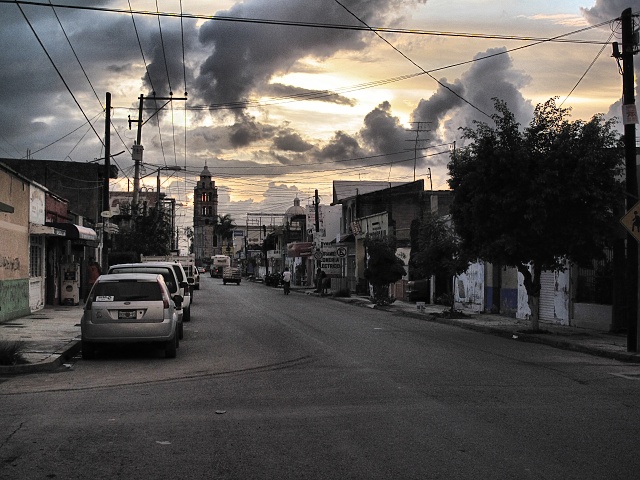
[Escuinapa de Hidalgo] Dramatic twilight
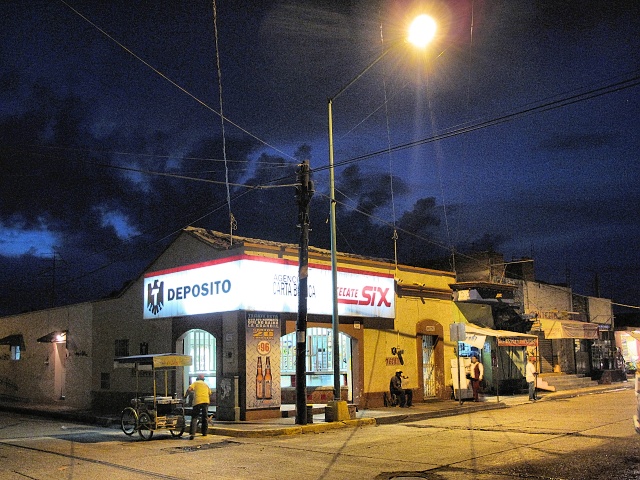
[Escuinapa de Hidalgo] Nightlife is concentrated around the beer stores, this one is of the Tecate brew
The next day it was similar, a flat road in the countryside, without a verge and with fairly heavy traffic, despite the fact that a paid “highway” ran parallel. I even cycled on it several times because the unpaid road sometimes merged with the paid one. The highway was generally a somewhat better road with two-way traffic, one lane in each direction (there were also better sections). But mostly it had a verge, so I did not have to constantly monitor the buzz in the rear-view mirror and make space for the big beasts. I crossed the border of the State of Sinaloa, arriving at Nayarit. In the evening, it was heavily overcast. I cycled to the small town of Rosa Morada, with only one hotel, the Gomez, a tiny room for 8 USD per night. Just after I closed the door of the room, heavy rain began to fall, lasting the whole night. And as if a copy of the previous day, the next morning was azure.
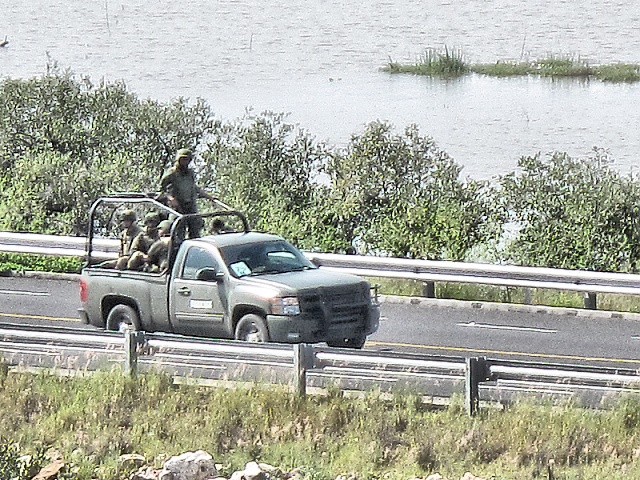
[Near Ojo de Agua] Soldiers patrol with drawn guns

[Near Ojo de Agua] Prawns drying in a parking area
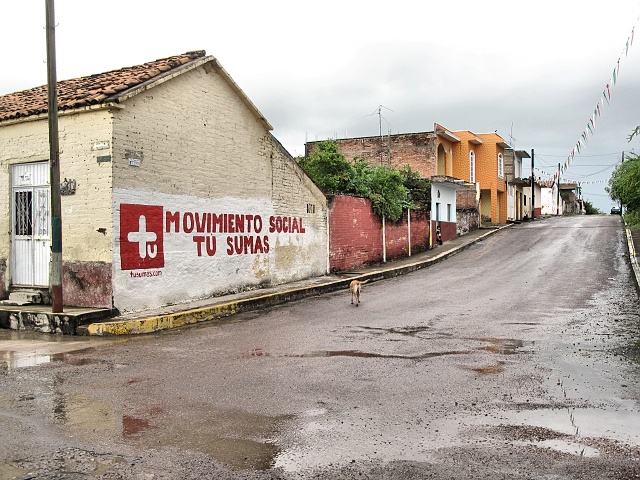
[Rosamorada] One of the lanes
The Pic in Tepic
I knew that it would come to the crunch that day. I was at an altitude of about 50 meters and Tepic, where I was headed, lay at 920 meters. Nothing happened for the first 50 kilometers. It was still a plain, but it was clear that drudgery lay ahead. And it was. The climb was pretty steep and, to undermine morale even more, after several steep inclines, the laboriously sweated out height was lost by a steep descent. I was sweating as never before in my life. There was no dry part of my shorts. Added to this, there was heavy traffic, the road was without verges, so I had to watch the mirror all the time and sometimes had to move sharply to the edge of the road to make room for trucks. They behaved considerately, but in some places they really could not pass around me. At about 16:00 the heavy rain started. I was not wearing waterproof clothing, so it did not matter whether I was wet from sweat or rain. The rain rather brought me some refreshment and relief from the heat. I was really happy when I bumped into the city center and found a hotel of adequate hobo quality. I had to wash my clothes completely due to the sweat and so decided to relax for a day and see the capital of the State of Nayarit.

[Capomal] Huaynamota River with mountains in the background
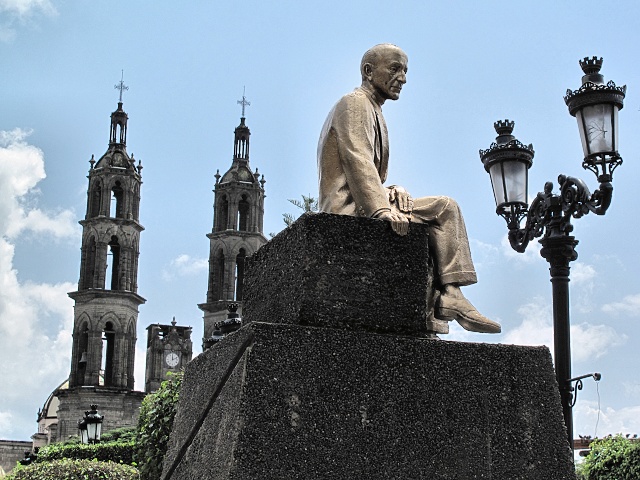
[Tepic] Plaza Principal is dominated by the Cathedral and statue of the poet, Amado Nervo, a native of the city
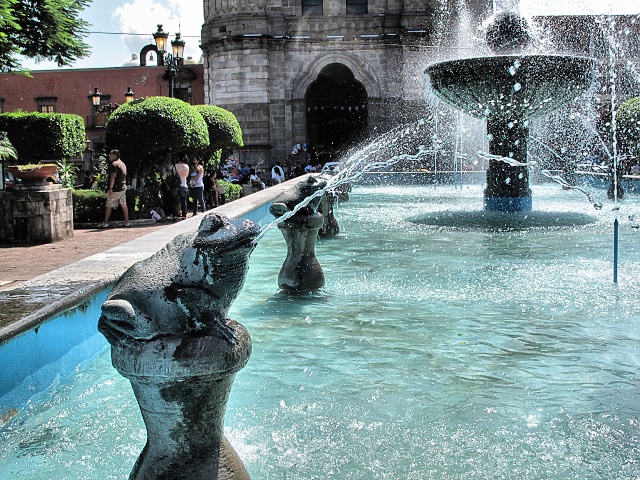
[Tepic] Frogs spouting in the fountain in front of the Cathedral
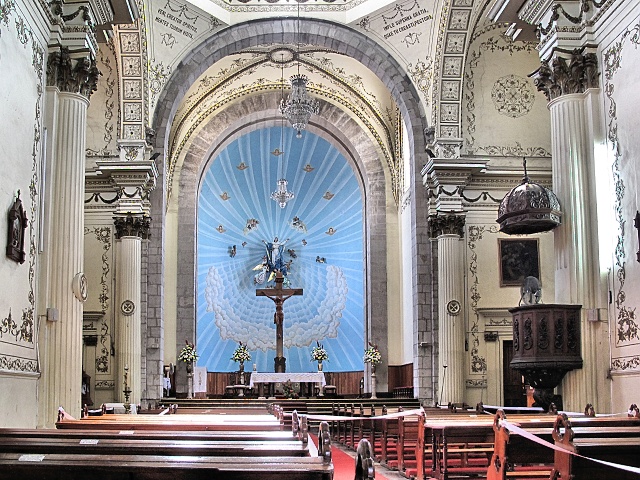
[Tepic] Cathedral altar depicting the Ascension of the Virgin Mary
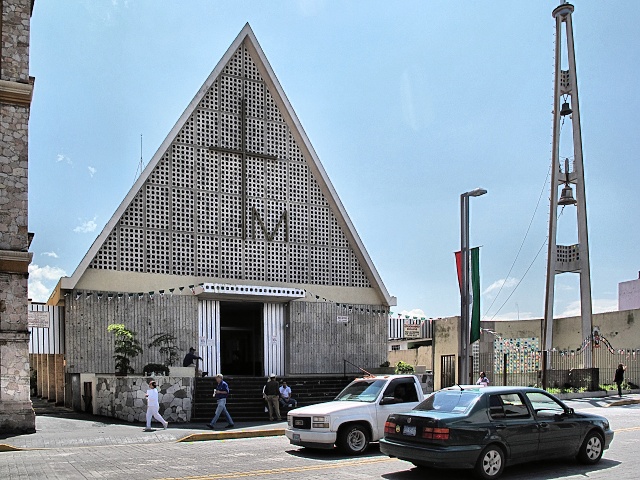
[Tepi] Extremely ugly prefab (?) church in the center
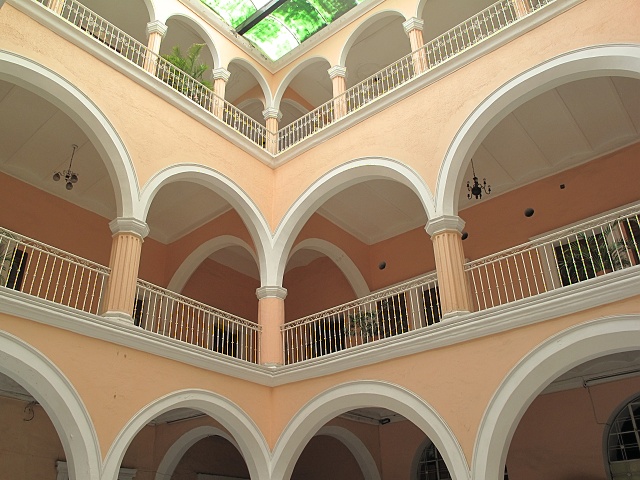
[Tepic] Several houses have been impressively renovated

[Tepic] Palacio de Gobierno, 1999 painting by José Luis Sota - the Mexican holy trinity - Carranza, Villa, Zapata
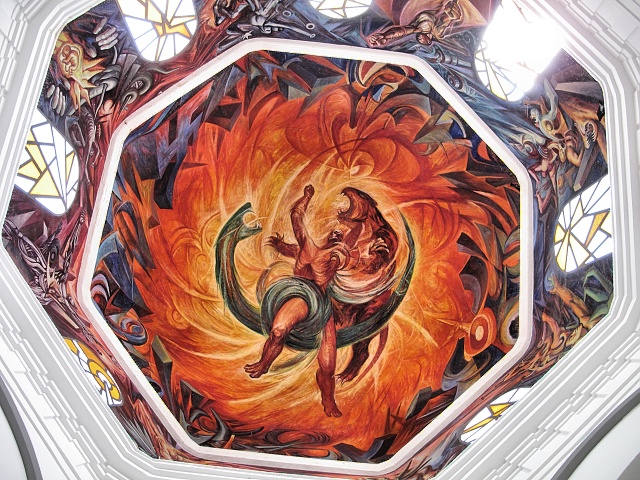
[Tepic] The artist, Soto devoted an entire dome to the representation of hell, a central theme here
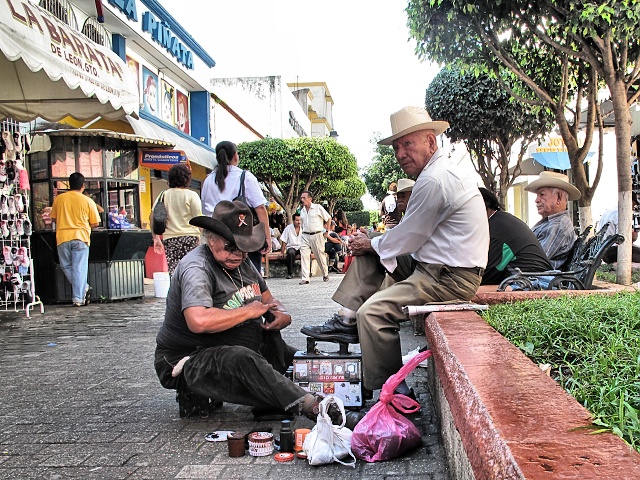
[Tepic] Every good caballero will have his shoes cleaned and discuss current events with his shoeshine man in the morning; there were at least 50 shoeshine men in the center
The rest in Tepic made me feel good. On the following day, I set out refreshed and filled with strength to grapple with the local hills. One day was sufficient to sightsee in Tepic, where actually, there is nothing to see. The terrain was not so bad. From the beginning, there was a steady climb and then a breathtaking descent to the valley surrounded by volcanoes that had last been active in the 19th century. I was not racing at all, and so after 90 kilometers, I found accommodation in the town of Ixtlán del Rio with about 30,000 inhabitants. It surprised me, clean streets, quite good sidewalks even in the side streets, a park in the center and plenty of people of pensionable age, as well as parents with young children.

[Near Chapalilla] The road led through a pleasant valley surrounded by volcanoes. The one in the center is Tepetiltic

[Volcano El Ceboruco] Mounds of lava beside the road from the last eruption in the 19th century
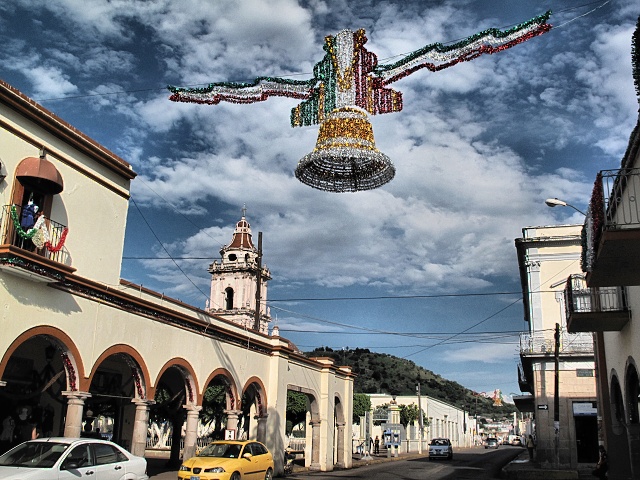
[Ixtlán del Rio] Clean, according to local standards, and tidy town, with sidewalks not posing the risk of a leg fracture
The next day was a lot sportier. First, about 12 kilometers of steady climb to the border of the State of Jalisco, then a steep descent of 400 vertical meters, the road half blocked by boulders from rock slides on every bend. I wondered when the road guys would start to clear the road, which was a danger to life at times, but I did not meet any of them. It was a Sunday and so they were leaving it for maòana. The descent was so steep that I even had to pass a truck, which apparently did not believe in the power of its brakes and was traveling very slowly. A steady uphill of more than 20 kilometers followed, quite steep at the end. I had to get used to it. Indeed, it would not be getting any better from there on. The conclusion was pleasant. First, a gradual descent into the town, where even the strong headwind did not bother me due to the downhill. There was a gathering of people outside the church, everybody in their Sunday best, the men in starched white shirts with pewter buttons and the obligatory sombreros. Then I realized that there was a fair in the town, apparently celebrating a local Saint, and the square and its surroundings were really abuzz. Not only were there many stalls and taprooms, but different music echoed from every corner. I was most interested in a female band that was playing blaring, rhythmic brass music of the Balkan type. The girls were swaying their hips to the rhythm. The oldest in their twenties, lustily, the younger ones cutely and the youngest of about nine years old, who was a trumpeter, focused only on her playing, standing as straight as a board, as if in a music school. A generally good mood prevailed. People had come to have fun and spend some money, there would be plenty of time for worries again on weekdays.

[Ixtlán del Rio] Tumba de Tiro – tomb, the figurine displayed in the morning mist

[Magdalena] A girls’ band played shrill and catchy Balkan brass music at the funfair
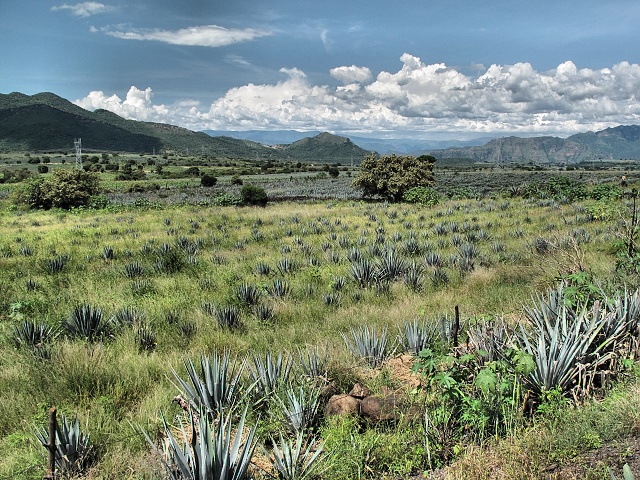
[Near Tequila] Valley surrounded by 3,000-meter high mountains, mostly of volcanic origin

[Tequila] Horse-riding is common, sometimes also in cities
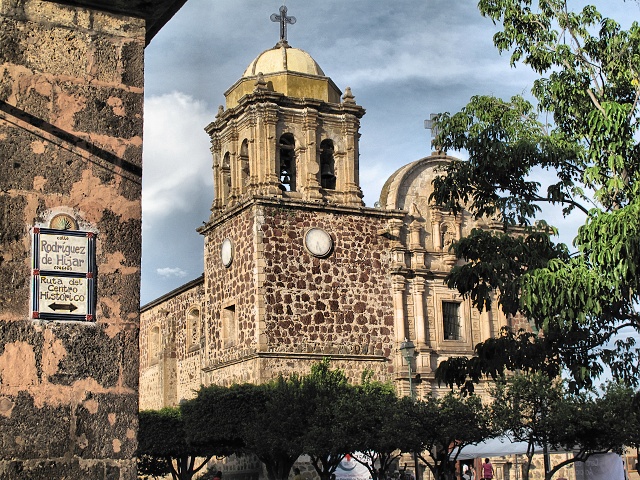
[Tequila] Cathedral
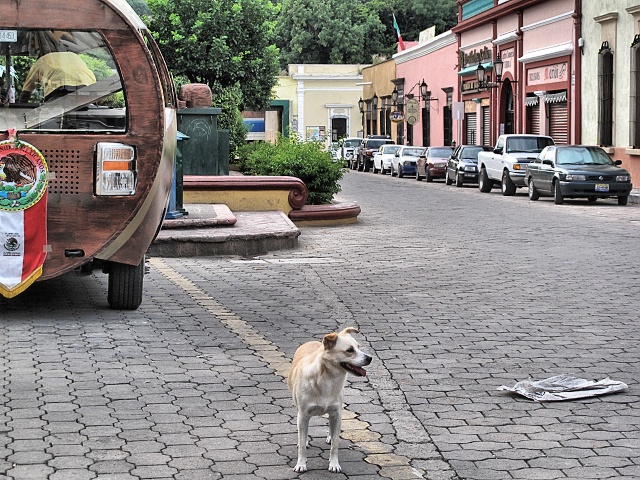
[Tequila] Stray dogs are part of every village and town
To the Source of Liquor — or how I got Smashed
In Tequila, the main product is, as those of above-average intelligence among you surely already suspect, Tequila. The José Cuervo factory has been producing it for 250 years (those drunken ones). The factory organizes tours of its production facilities – I managed to get in for the last one, even though I thought I had a reservation for an hour later – in the State of Jalisco the time had advanced by one hour again. Everyone was given a hairnet, I did not put mine on, reminding them that I had a bald skull under my hat. They did not acknowledge this and so I had to wear the hairnet too.
The tour was worth it, we got a taste of raw Agave, then fermented, which is sweet and has a pleasant flavor, something like molasses from Agave. But in particular, Tequila at various stages of the manufacturing process, during which the taste of the nasty smelling alcohol dramatically improved. One of the three guides was responsible for the supply and assumed his duties responsibly, pushing Tequila on to us with all his might. Two American girls began to have problems holding their cups in the middle of the tour and the crafty supplier, seeing that he was on to a good thing, pushed even harder. I do not drink spirits, but there of course, I could not refuse. Only the Margarita which was served at the end of the tour overpowered me, when I was already feeling that I'd had my limit.
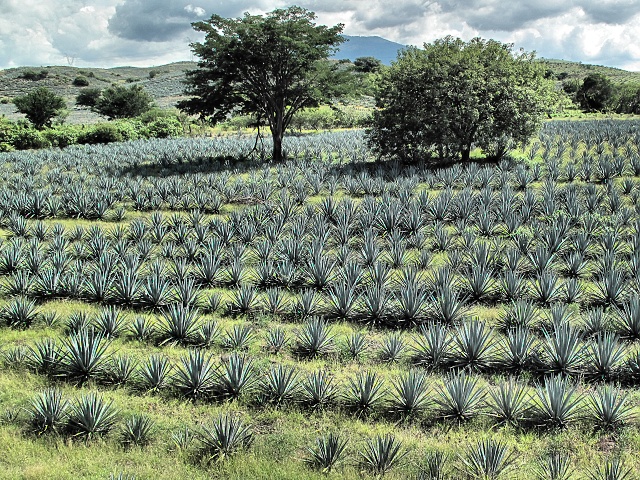
[Near Tequila] Agave is grown like this, the main raw material in Tequila production
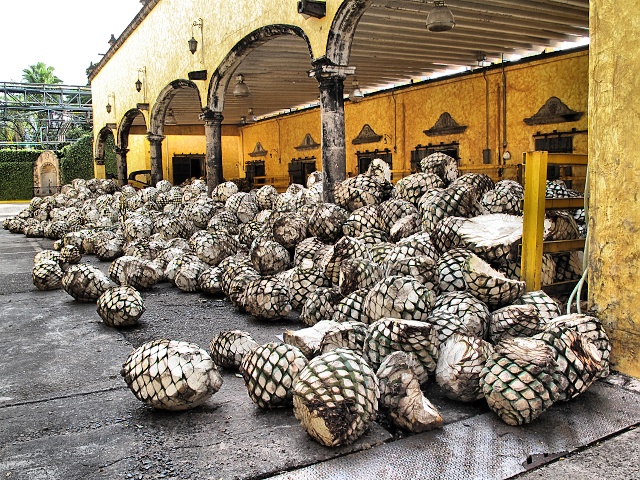
[Tequila] Tour of the Mundo Cuervo Tequila factory - raw Agave ready for processing

[Tequila] Tequila factory tour - line for processing of fermented Agave
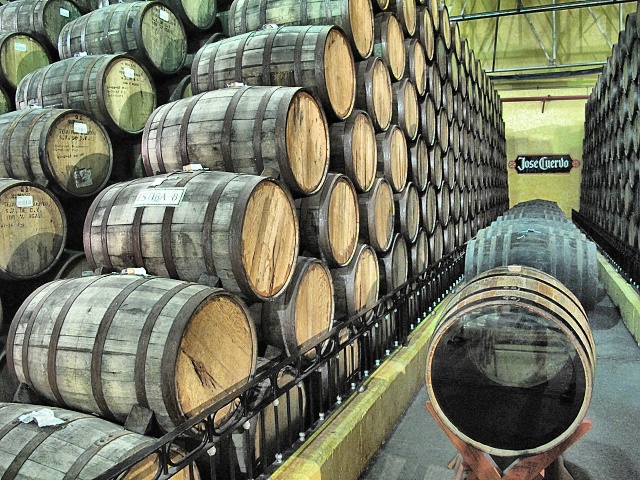
[Tequila] Tequila factory tour - aging in barrels
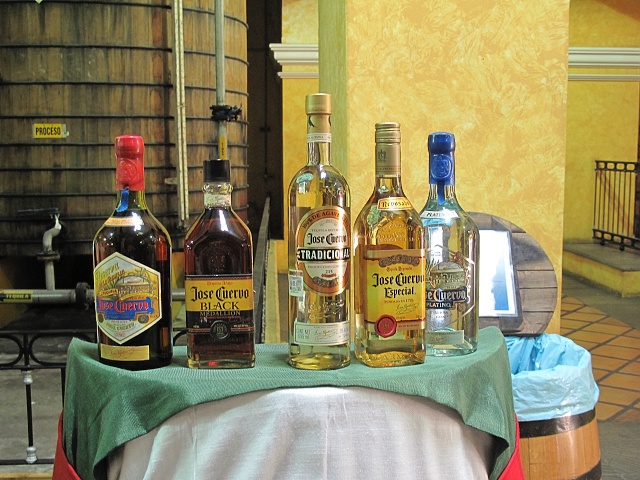
[Tequila] Tequila factory tour - the final products
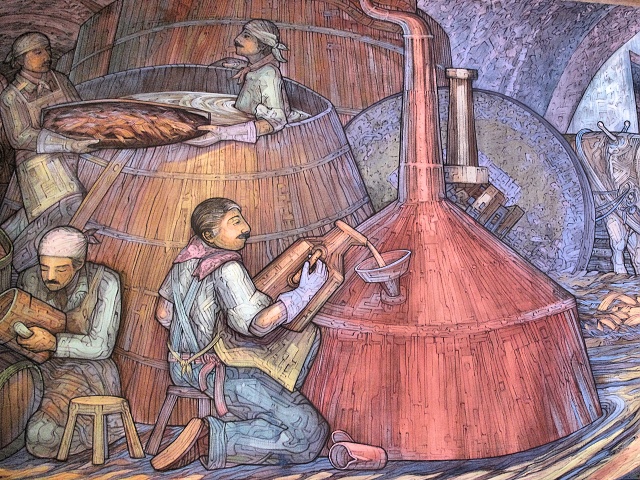
[Tequila] Tequila factory tour – detail of extensive fresco

[Tequila] Tequila factory tour - this rascal delighted in pouring Tequila for us
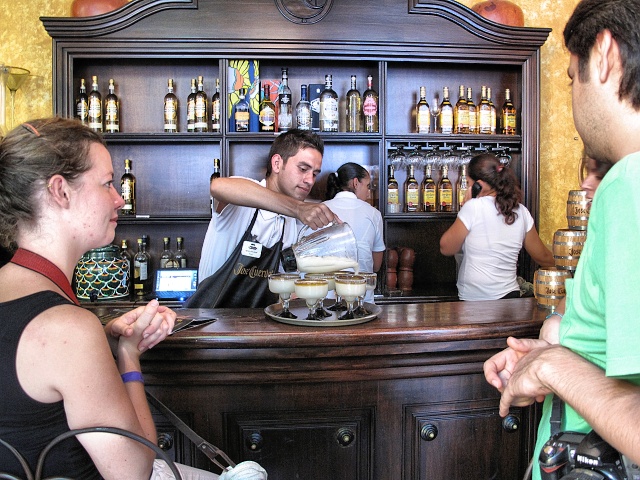
[Tequila] Tequila factory tour – they finally finished us off with the Margaritas
As I was leaving the next morning, I found out that the battery of my cyclocomputer was totally run down. I had not managed to download the data from the last two days. I replaced the battery and the computer was totally reset. When the battery had been replaced the last time in Japan, not only was the setting preserved but also all the tracks had been recorded. I hoped it did not indicate any serious defect, as I very much enjoyed the cycling statistics.
To the Big City
Guadalajara is Mexico’s second largest city, the entire metropolitan area has 4.1 million inhabitants. I set out a little shaken by the loss of the data from the cyclocomputer and only the persistent rotation of my legs got me into the right mood. The road was basically uphill all the time, but there was no need to push, I could pedal comfortably. The traffic volume increased, especially after the unpaid road merged with the paid highway. In the beginning, the road had a wide shoulder, then the verge disappeared and I had to teeter on the white line, with a steep one-meter deep concrete drainage ditch on the right side. I was reluctant to fall into it, but I almost did when two dogs from a building next to the road ran towards me, frantically snapping at my feet. I shouted at them as usual “down!”, but those rogues were persistent. I was watching cars from the left, fighting off the dogs and almost falling into the ditch. Dogs were quite a problem, this was an everyday situation. I wanted to buy a pepper spray, but it is reputedly illegal in Mexico. Oh-oh, where would I find a dog-catcher?
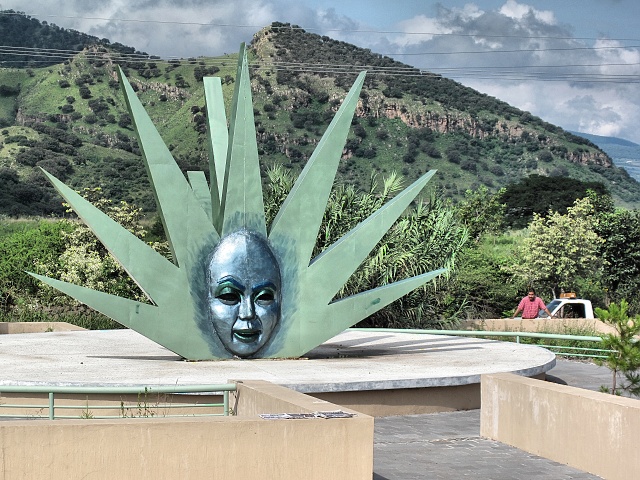
[Near Tequila] Monument to Agave
A Real Challenge
…is what I was thinking, as I approached the city boundary. And it surpassed my worst expectations. The usually decent and considerate drivers suddenly became mindless machines focused in the afternoon peak hour traffic on preventing cars from the parallel lane from pushing in front of them, so they drove bumper-to-bumper behind each other. The traffic was flowing in several lanes, the verge was broken, interrupted by various drains and potholes. I had to take a narrow track as if on rails, basically the white line (but mostly it was not marked), and had I deviated perhaps even 30 cm to the left, they would have swept me away. I also got hit on the head (luckily I was wearing a helmet) either from a mirror of a monstrous SUV or from a passenger’s elbow stuck out of the window. The most difficult section lasted for about 10 kilometers and could not be avoided. The sidewalks were unusable as they were like a ploughed field with many traps. I tried the parallel roads too, they were equally jam-packed and the surface quality even twice as bad as the main road. The worst moment was passing through an unlit tunnel of about 200 meters in length. There I actually thought that I would be knocked down by a vehicle. The situation suddenly changed after turning into the city center. The streets improved, the traffic eased off. I wiped off my sweat and started searching for suitable accommodation. I cycled to three hotels in the center, liked the last one, chose a room and checked in. It was too bad I did not have the previous day’s liquor to wash away the horror.
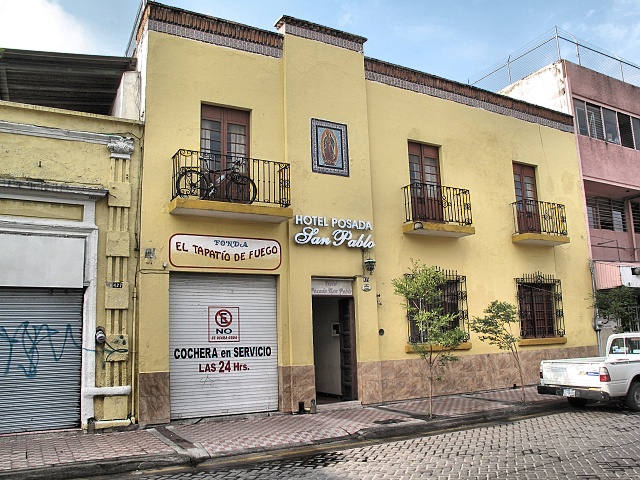
[Guadalajara] I stayed here. Guess which room?
Guadalajara
I had reserved two days to explore the city and that was quite enough for me. The city center has a very European appearance, with wide boulevards, clean and passable sidewalks, extensive car-free pedestrian zones. Streets have been moved underground. The wider area of the center, however, is again Mexican. The center is dominated by the Cathedral whose construction began in 1558. Its disproportionate towers look strange, a consequence of the fact that, after the original towers collapsed during the 1818 earthquake, the towers were rebuilt in the middle of the 19th century, but much higher than the original ones. All in all, it is a somewhat messy style of construction, but the whole works well, except for the aforementioned towers. There are many churches from the colonial period. I went to see the most important. There is a statue of St. John of Nepomuk in the Cathedral. He is popular in Mexico (although I doubt that most Mexicans know about his connection with Bohemia). The interior of the Cathedral is decorated in white and gold, and when eight red-robed priests served Mass, it was an impressive sight. But I liked the Templo de Aranzazú most of all. It has a small, constricted interior of raggedly carved wood and is heavily gilded. The first impression is that one has entered a treasury.

[Guadalajara] Plaza de la Liberacion and a view of the Cathedral

[Guadalajara] The interior of the Cathedral
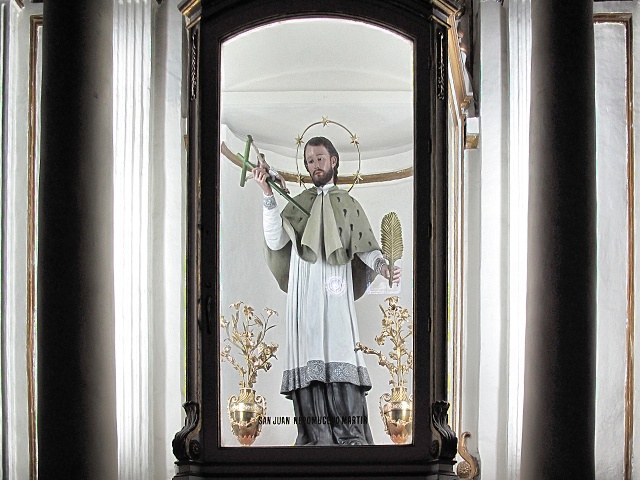
[Guadalajara] St. John of Nepomuk is very popular in Mexico, here is his statue in the local Cathedral
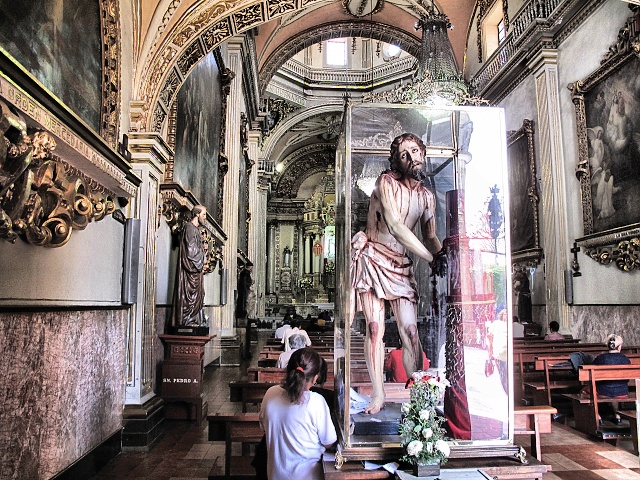
[Guadalajara] Church of Nuestra Seòora de las Mercedes – people pray to the statue of Christ and place their written wishes on the pedestal of the sculpture
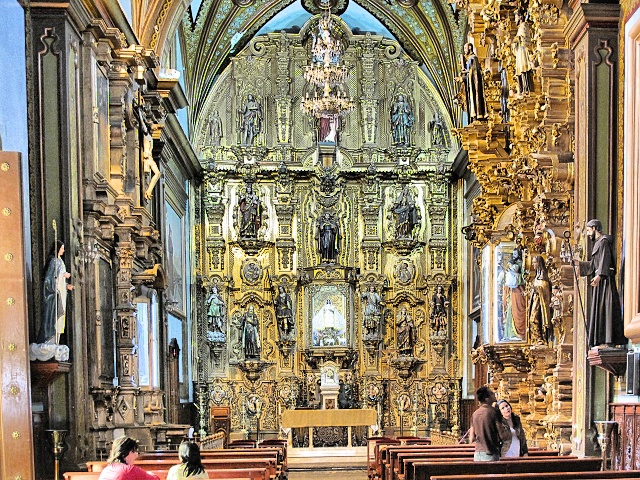
[Guadalajara] Templo de Aránzazu - the prettiest of the local churches
Instituto Cultural de Cabanas, originally an orphanage, is a building on the UNESCO List. The large building gives a very intimate feeling. It is segmented into a series of patios, which are mostly surrounded by covered arcades. There are orange and palm trees growing in the courtyards. However, the main attraction are the murals painted by José Orozco in 1938-9 in the rotunda of the main building. These have now been repaired. There was scaffolding in the center of the building and visibility of the paintings was not perfect. However, even the little I saw seemed to me very Orwellian, totalitarian, Bolshevik. The painter apparently wanted to issue a warning against approaching Fascism.
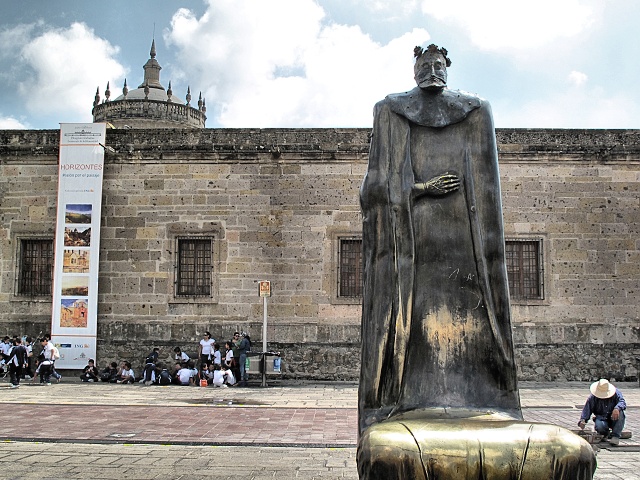
[Guadalajara] Plaza Tapatia - Instituto Cultural de Cabanas in the background
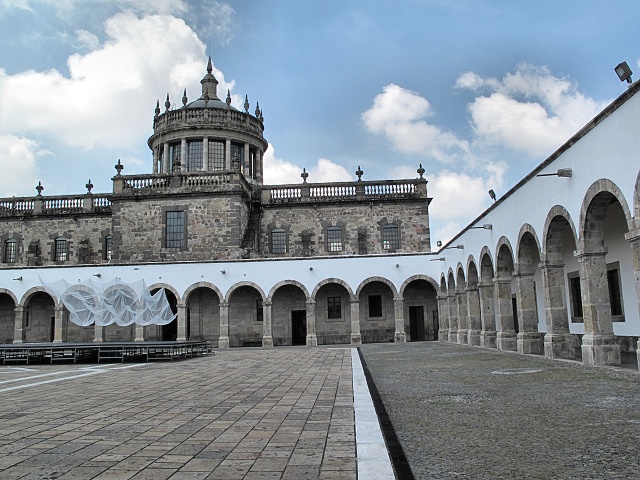
[Guadalajara] Instituto Cultural de Cabanas – the largest of the patios is lined by arcades
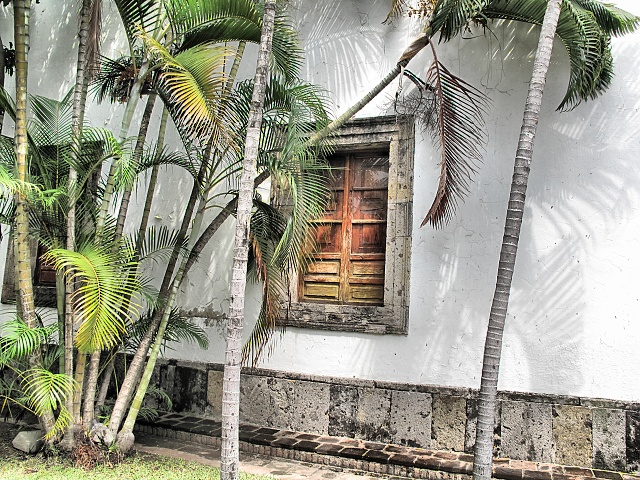
[Guadalajara] Instituto Cultural de Cabanas – a corner of one of the patios
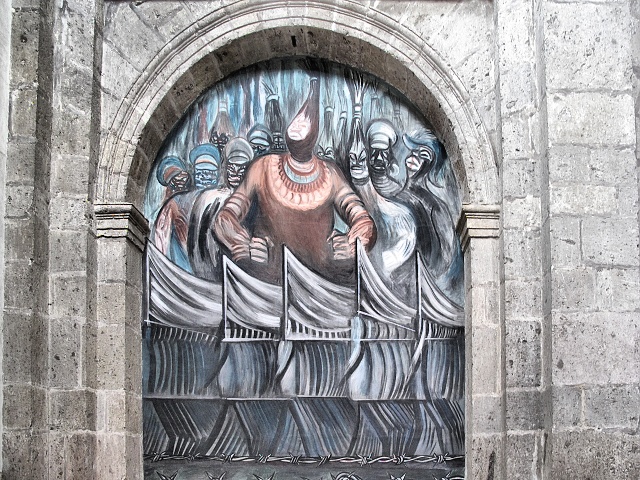
[Guadalajara] Instituto Cultural de Cabanas – 1938 fresco by artist, Orozco
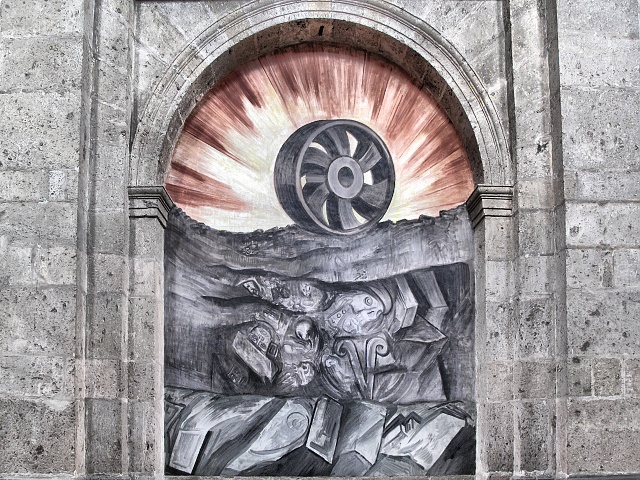
[Guadalajara] Instituto Cultural de Cabanas – 1938 fresco by artist, Orozco
Mercado San Juan de Dios is a tourist attraction and also a good source of fresh and tasty food. This marketplace occupies the estimated area of a football field. It has several floors and is packed to bursting with food, fruit and vegetables, electronics, including apparently illegally sold software, clothes, hand-crafted products, odds and ends and dozens of food stalls. Halves of cows and pigs hang in the butcher stalls, intestines, heads with eyes and a corresponding smell. The aisles between the stalls are pretty narrow, so everything is cramped and crowded with locals busily shopping. I am not a particular fan of it, one visit was enough for me.
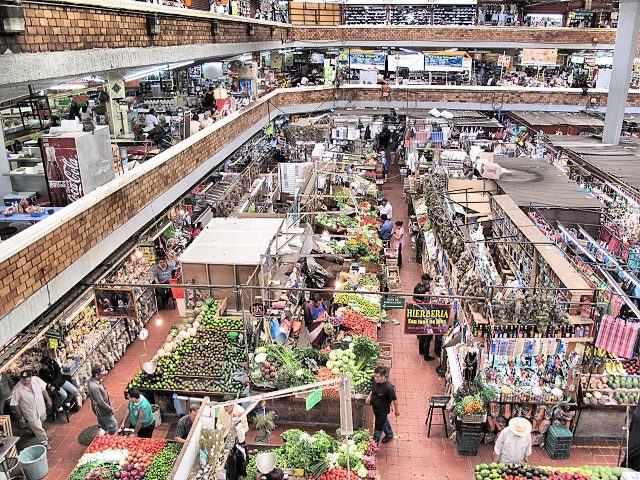
[Guadalajara] San Juan de Dios marketplace offers a plethora of goods and services and of course dozens of food stalls

[Guadalajara] Food stalls are very popular in San Juan de Dios marketplace
Otherwise, the center is very pedestrian-friendly with many benches, refreshing fountains and statues. The policemen moving around the area on bikes were rarely unarmed. A huge student demonstration took place on the Wednesday, enjoyed by all the kinds of cops. Bus transport was unavailable for half a day, dozens of Police motorcycles and cars were everywhere, honking and flashing their lights like little boys. In addition, helicopters were flying above all this. The demonstration had a typical development. While the speakers were still beating their breasts and delivering their fiery speeches, most of the demonstrators had already eaten their tacos and ice cream and were lounging around in shady corners.
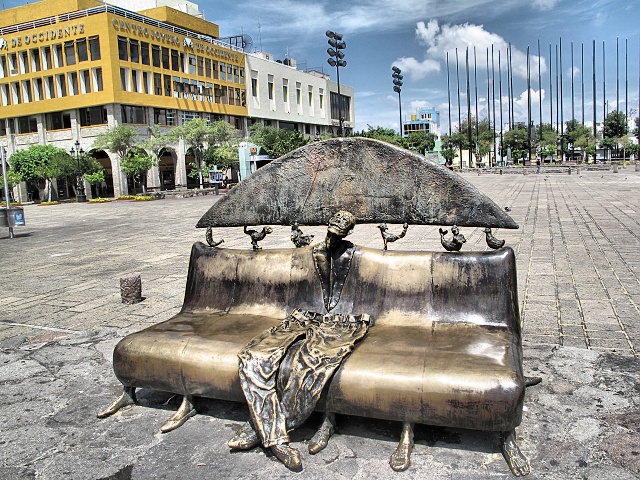
[Guadalajara] Plaza Tapatia
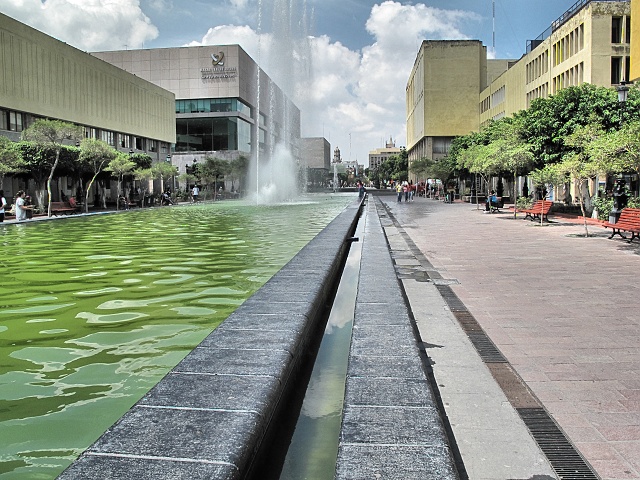
[Guadalajara] The pedestrian zone in the center is a few hundred meters in length
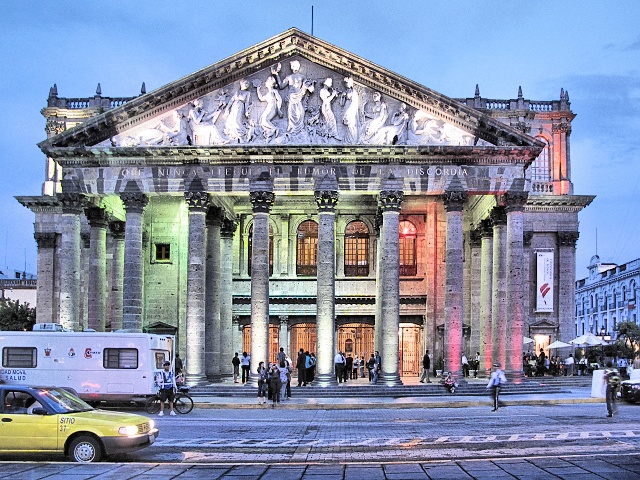
[Guadalajara] Degollado Theatre before the start of the performance
In the year that I was there, Mexicans were celebrating 200 years of independence and 100 years since the Revolution. It was noticeable that they greatly value their heroes. Streets are named after them in every village and Guadalajara boasts an enormous number of monuments to these national heroes (there are 40 just around the Rotunda).

[Guadalajara] Padre Miguel Hidalgo began the Mexican struggle for independence 200 years ago (on September 16, 1810) and paid for it with his life
In conclusion, a few general reflections: On the last day of September, I planned to go to the largest Mexican lake, Laguna de Chapala, and then move through the mountains nearer to the capital city of Mexico.
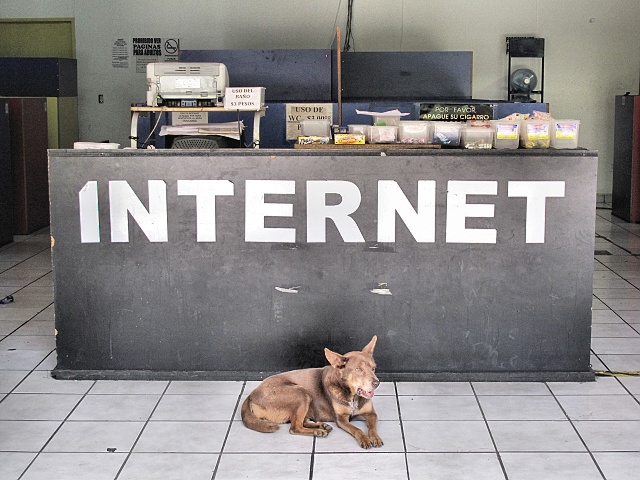
[Guadalajara] It is definitely no problem to connect to the Internet in Mexico
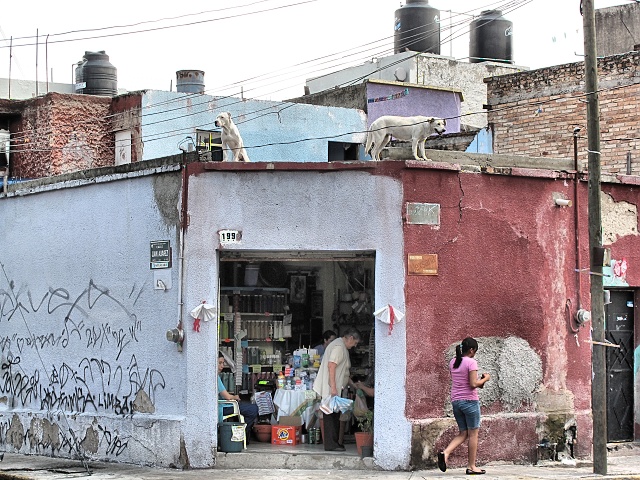
[Guadalajara] Typical small garage store, uncharacteristically guarded by dogs on the roof

[Guadalajara] It seemed like Spring in the city



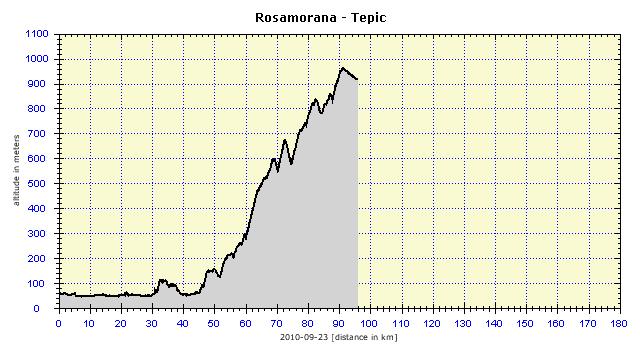
I could not download the profiles from 25th and 26th September from the cyclocomputer due to the sudden discharge of the battery.
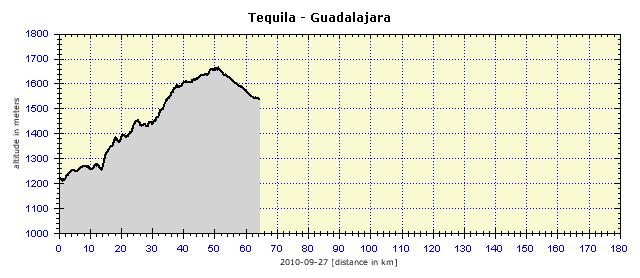
| 








































































